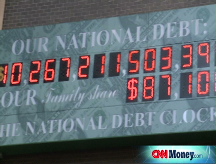Here comes stimulus - question is how
Momentum is building for a new program to boost economy. But Democrats and Republicans have very different ideas on how to do it.
NEW YORK (CNNMoney.com) -- The drumbeat for lawmakers to do more to boost the economy is growing louder. And the chances have increased that Congress could pass a second stimulus package during its lameduck session following the presidential election.
Over the weekend, Ed Lazear, the president's chief economic adviser, said that at least "parts of the country" are already in recession.
On Monday, Federal Reserve Chairman Ben Bernanke told House lawmakers that "consideration of a fiscal package by the Congress at this juncture seems appropriate" given the risk of a "protracted slowdown."
And the White House said again that President Bush would be "open" to ideas for a second stimulus package, although press spokeswoman Dana Perino added that the administration would want to see details first before signing on. The administration believes that many of the proposals being discussed would not stimulate the economy.
Subtext: one person's idea of stimulus is another person's idea of pork.
Indeed, the path to enacting a stimulus measure is fraught with political and economic complexity. It has to be timed right and contain the right measures. It's more art than science.
Democrats have been pushing for a second stimulus package for months. Many of their proposals have featured direct cash assistance, while Republican plans have been focused more on providing tax incentives and tax breaks.
Among the proposals from Democrats: extend jobless benefits, increase food stamps and invest more money in infrastructure projects to create jobs in the near term.
Critics of the infrastructure spending idea say it takes too long to work as economic stimulus. But proponents say it can create jobs if the money is put toward projects that are ready to go but for the funding.
The American Association of State Highway and Transportation Officials estimates that $18.3 billion worth of such projects are pending.
Democrats have also called for a moratorium on foreclosures and for making permanent a temporary increase lawmakers passed last February on loan limits for mortgages that may be backed by Fannie Mae, Freddie Mac and the Federal Housing Administration.
The temporary increase on those limits to $729,750 was intended to make mortgages in high-cost areas more affordable. Previously, any loan over $417,000 was subject to higher rates. Under current law, the loan limits will fall to $625,500 next year if no changes are made.
Democrats have also been pushing for a reinstatement of seller-paid down payment assistance, which was prohibited in a housing bill signed into law this summer. The Federal Housing Administration, which backs affordable loans for borrowers with low-income or less-than-stellar credit, has said down payment assistance leads to too many homeowners defaulting.
Democrats, however, have been proposing more restrictions be placed on the provision so that it would result in far fewer losses to the FHA.
Republicans would prefer that stimulus measures include more tax breaks than direct payments. Among them: a temporary reduction or elimination of the capital gains tax on stocks and lower income tax rates for companies that buy distressed assets.
House Republicans are also calling for purchasers of homes that are not primary residences to be entitled to the same capital gains exclusion as owners who sell their primary residences. Currently, a single homeowner can exclude $250,000 of capital gains on a sale, while couples can exclude $500,000.
The proposal would only apply to people who bought second or third properties over the next 18 months and held their properties for at least five years.
"This could help take foreclosed properties off the market, raising home values," said House minority leader John Boehner, R-Ohio.
The presidential candidates, whose crisis-related stimulus plans differ in most ways, nevertheless both call for suspending the income tax on unemployment benefits and temporarily exempting seniors over 70-1/2 from having to make any withdrawals from their IRAs and 401(k)s.
Meanwhile, Bernanke suggested to lawmakers on Monday that they include measures "to help improve access to credit by consumers, home buyers, businesses and other borrowers."
Among the possibilities, he suggested that there could be more direct lending from the federal government to states - which are suffering from a budget crunch - as well as to consumers and businesses. Tax credits are another option, he said.
Economists caution that any stimulus package must be well timed or it risks doing more harm than good.
Of course, that's easier said than done.
Bernanke said Monday that stimulus should be enacted when things are at their worst.
"Any fiscal package should be structured so that its peak effects on aggregate spending and economic activity are felt when they are most needed, namely, during the period in which economic activity would otherwise be expected to be weak," Bernanke said.
But Lakshman Achuthan, managing director of the Economic Cycle Research Institute, thinks ideally the best time for stimulus is at that crucial turning point between recession and recovery.
"[It] would be most effective if it hit the economy when it was already on the cusp of an upturn, thereby creating more of a V-shaped recovery. As of today, we do not see any sign of recovery in the next few months," Achuthan said.
Of course, the lag time between when legislation is passed and when it goes into effect can be two different things. The first stimulus package was passed last February. It consisted mostly of tax rebates. The rebates were first sent out in late April and continued into the summer.
The verdict on the effectiveness of those rebates is mixed to negative: While they boosted consumer spending in the short-term, they didn't do so nearly as much as they boosted consumers' savings or ability to pay down debt, neither of which is considered a short-term boost to economic activity.
The initial outlay for that first package, which also included business incentives, was $168 billion. This time around, depending on which measures are used, the cost could run between $150 billion and $300 billion. ![]()






